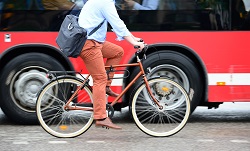Active mobility pairs up with transport in the healthiest cities
Governments are acutely aware of the growing public health threats from obesity and related medical conditions. Authorities often respond by encouraging physical activity, through sport and leisure activities, yet such approaches have proven inadequate. Not everyone is willing or able to participate in such forms of exercise. Promoting AM (walking, cycling solely or in combination with public transport) is an alternative solution to increase physical activity that, by the way, helps to reach goals on transport planning. Compared to sport, AM requires less time and motivation, and appeals to a wider group of people. AM is also easily integrated into daily life. The European picture Cities in Europe are widely seen as walking and cycling-friendly. Yet, the continent actually displays considerable variation, with some areas having very low walking and cycling rates. The EU-funded PASTA project studied measures to promote AM as well as AM’s health benefits and effectiveness through comparison of seven cities (Antwerp, Barcelona, London, Orebro, Rome, Vienna and Zurich). The study also examined associated dangers such as pollution and traffic. Results indicated that even in cities having good cycling or walking rates, AM remains incompletely implemented. According to project leader, Elisabeth Raser, policies and goals alone do not guarantee results. “We found that change needs political will, courage and cooperation among different stakeholders,” she says. New solutions To help improve matters, the team surveyed 61 stakeholders across the 7 cities, and collated 138 AM-promoting suggestions. Most involved the development of infrastructure or the social environment. Other categories included strategic policy and also regulation and legislation. The PASTA team also highlighted eight European examples of good practice that have been implemented successfully. Over 2 years, researchers conducted a longitudinal study involving over 10 000 participants. They concluded that AM increases levels of physical activity and reduces transport-associated emissions. Positive benefits of increased exercise, via walking and cycling, also outweighed the potential harm from air pollution or risk of crashing. Modelling indicated a relationship between the extent of cycling networks and the amount of cycling activity. In health terms, the ideal case would be for all streets to have some cycling infrastructure. The PASTA team showed that a 10 % expansion of existing cycling networks would offer governments the best spending-benefit ratio. Project work further showed that regular cyclists generally have lower body mass indices than motorists. Additionally, 90 % of cyclists achieve the recommended levels of daily physical activity compared with only 29 % for non-cyclists. If all 167 European cities achieved a cycling rate of around 25 %, approximately 15 000 premature deaths could be avoided annually. Lastly, the team also contributed a revision to the World Health Organization’s software tool that assesses the health and economic benefits of exercise. The PASTA team’s new modules address air pollution, crashes and carbon. Ongoing research to further active mobility “We were able to collect one of the biggest data sets in the field of transport and health,” notes Raser. However, not all could be analysed during the project. So, although PASTA has concluded, team members will continue analysing the data and presenting project results. The PASTA project confirmed that AM is an effective and popular way to increase population exercise rates. In future, we may see green pathways and bicycle racks supplementing more traditional elements of health infrastructure.
Keywords
PASTA, exercise, health, cycling, walking, physical activity, active mobility







